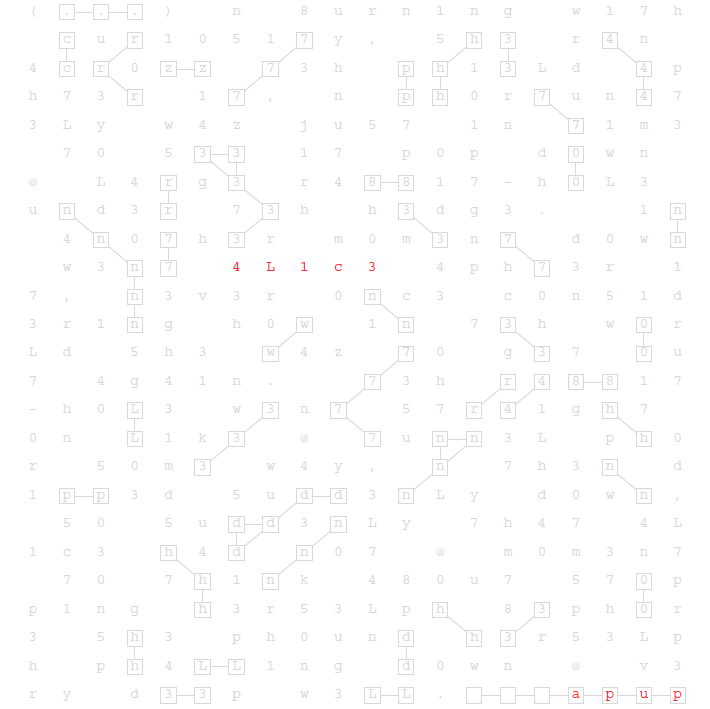3.13.2016 ― L33T way of literature
On train to Kuopio idling away my time

Background
Your life seems sometimes quite limited. Jammed in a train without much options, you'll just might to end up in restaurant wagon (best place for all lost souls) - waiting the sceneries to pass while your tea is getting colder. To idle my time, I had a chance for R-on-rails experimenting. On the menu there was an inspiration for text graphics.
My idea was to take a piece of text, turn it to L33T [1] format and by place character-by-character on the canvas. This way, I would end up with a very characteristic poster. Pun intended.
L33T
As train from Hki to Kuopio is about 4 hours, there isn't that much time to figure out all the possibilities with the text modifying. Options for leet adaptation were to use
- basic leet = y0ur m4rv3l0u5 3x4mpl3 73x7
- advanced leet = !7 |-|45 |3!7 /\\/\\0|23 5|-|4773|23|) 57`/|_3
- or ultimate leet = `/3|>, +|-|!5 !5 0\\/3|2 |\\/|`/ |-|34|).
In this execution I decided to use basic leet. As there would be some space between the letters, it was more convenient when each letter is formed via one character - instead of several. Therefore, the basic style works best here and makes it readable.
Execution
For testing the idea, I took a sample from Alice's adventures in wonderland by Lewis Carroll. It is from the beginning of the book, when Alice starts her journey. This text clip had originally 500 characters, so I would be fine starting with 25 x 20 character canvas. The leet conversion would decrease overall character amount anyway.
The actual text conversion was performed with word rules that I choose to use. I did took the easy path (prototype mode) and skipped basically the whole Wrong Grammar rules and took only the text clip related Intentional Misspelling rules. Basic leet alphabets and letter combinations were used.
To develop the poster I decided to work with basic R libraries, also due the fact that moving train had limited wlan access. Therefore, I created just basic Cartesian coordinate grid with plot()-command. I would insert the conversion text into it by processing it character by character. This is really the simplest R-art one can make.
As the canvas would have 20 char width, words wouldn't fit into the area as-they-are in general without either modifying the letter-spacing or cutting the words. To build uniform poster, I decided to continue the last word on line-end from the next line rather than mixing the letter-spacing. Though, the cutting words in line-ends should not be a problem. Don't rules #8, #20 and #42 from the Rules of Internet [2] already allow the typoing and girammtc errros for any written text? At least I thought so, but then I checked the Internet - 50% of the comments tend to be nowadays suggestions how to correct the OP's formatting. Of course it might be just proof of the natural behaviour as the rules #9 and #25 together lead to #26 (equation: 9. ∩ 25. → 26. ). Meh, just cut the words.
While the train passed the Chernobyl of Finland I had already managed to get not just the initial canvas settings and text conversion ready, but also started to ponder whether I should make some analysis component in it. For a long time ago, I encountered awesome Pi Day posters from Martin Krzywinski [3]. Martin has very inspirational works; I have a thing for anything colourful creativity and those hit my cells. Especially year 2015 poster contains an idea to connect neighbour values if they are equal. Connection would then form lined paths. So, I decided to connect identical neighbour characters in the name of...eh...random encounters?
Finally, I would set the colouring palette to look amusing and highlight couple of words for emphasizing reasons. In overall, the piece would be pale as lacking the common intensity of colour due fear. The world might be scary place for some. The great unknown even more. Alice herself would be bright red, as she was not prolly feeling any fear or doubt when entering the rabbit hole. She would stand from the ground.
End result
The final result is shown above. Can you see what it reads? And as you might observe, the information value of the is-my-neighbour-same-with-me character analysis is gigantic. Although, that randomness seems to be quite symmetric here and there. By adjusting the canvas width, the connector routes would look different.
And so I had arrived to Kuopio.
The restaurant wagon was done with these drinking-same-cup-of-tea-4h junkies. ∎